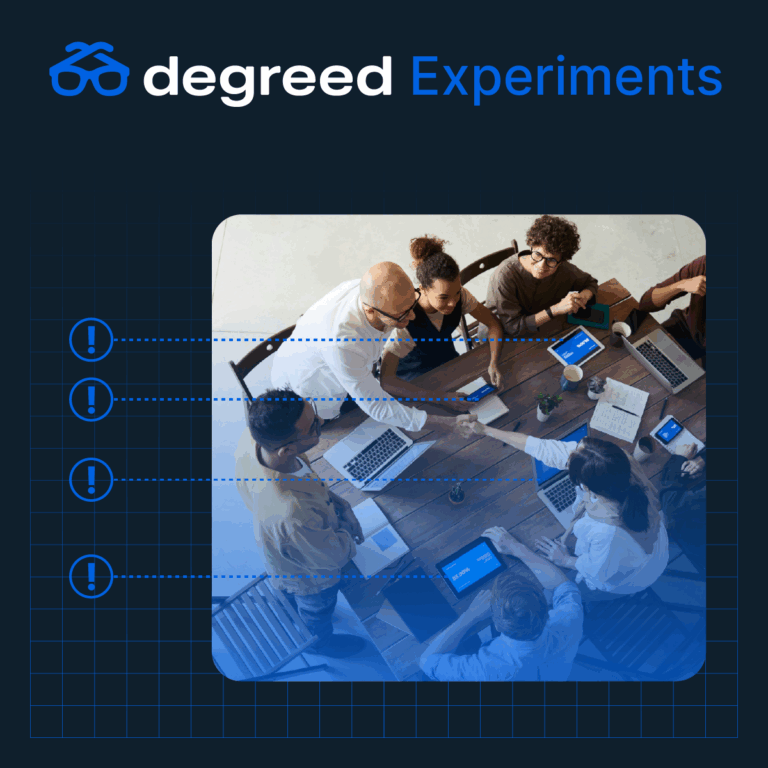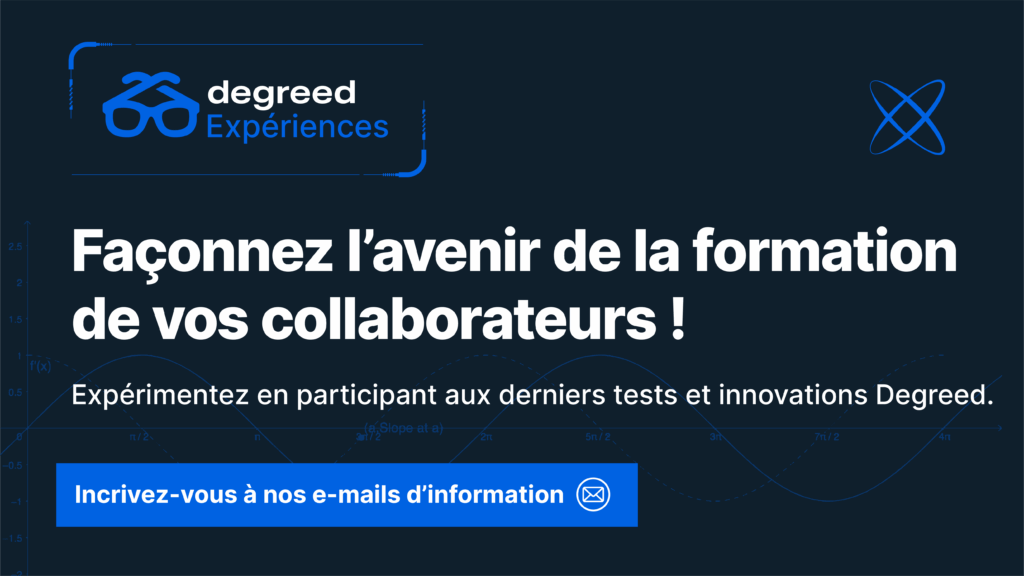
Expériences Degreed : pour une formation pratique et adaptative
L’un des attraits majeurs de l’IA conversationnelle vocale de Degreed Maestro réside dans sa capacité à créer des expériences de formation bidirectionnelles, personnalisées et adaptatives. Mais nous savons également que l’assistance vocale n’est pas l’interface idéale pour toutes les tâches de formation.
En effet, l’IA vocale ne répond pas aux attentes dans les cas suivants :
- Vous avez besoin de créer ou de saisir des informations complexes avec un niveau de fiabilité élevé.
- Vous avez besoin de repères visuels.
- Vous avez besoin de suffisamment de temps et d’espace pour résoudre des problèmes en profondeur.
- Les tâches impliquent des éléments non vocaux, par exemple des tâches nécessitant de taper du code ou de naviguer au sein d’une interface logicielle.
Nous nous sommes donc demandé s’il était possible d’exploiter les points forts de l’assistance vocale, à savoir son interactivité et sa capacité d’adaptation, et les mettre en œuvre dans des contextes non vocaux.
Notre dernière expérience : des exercices de formation adaptative
La réponse nous a conduits à développer une approche innovante de la formation par la pratique. Le concept est simple : vous commencez par un objectif de formation, puis celui-ci est décomposé en exigences de progression ou en étapes à franchir.
Ensuite, l’IA génère des micro-tâches, l’une après l’autre, pour vous aider à comprendre et à mettre en pratique ce que vous avez appris. Vous recevez immédiatement un feedback personnalisé après chaque tentative et la prochaine tâche est ajustée dynamiquement, en fonction de votre progression et de votre compréhension.
Premiers commentaires
- « J’ai trouvé cela intuitif. J’ai apprécié de passer à la pratique après chaque explication et description de tâche. »
- « De manière générale, c’était fluide. Le feedback que je recevais sur mes réponses était utile. »
Diversifier les modalités
Une interaction pratique était nécessaire. Nous avons commencé par la saisie de texte pour diverses tâches, puis avons pris en charge un éditeur de code pour les applications plus techniques.
Ensuite, nous avons intégré la webcam et les enregistrements d’écran. Ces derniers se sont révélés particulièrement précieux. Ils ont permis aux premiers testeurs de faire la démonstration de leurs compétences directement dans le contexte de leur travail ou d’applications spécifiques.
Premiers commentaires
- « J’ai apprécié de devoir non seulement écrire, mais aussi faire des enregistrements vocaux. Je pouvais ainsi consolider ce que j’apprenais. Cela a donné de très bons résultats. »
- « L’expérience était vraiment interactive et dynamique. »
Pour finir, nous avons ajouté des questions à choix multiples. En effet, il peut être lassant de devoir saisir du texte constamment. Ces questions constituaient donc une manière plus commode de confirmer sa bonne compréhension.
Parmi ces diverses modalités, l’IA peut sélectionner le format le plus approprié pour chaque tâche et séquencer l’ensemble de manière progressive, afin de réduire efficacement la charge mentale. Concrètement, cela signifie généralement que les utilisateurs commencent par des questions à choix multiple pour valider les bases, passent ensuite à une saisie de texte ou de code pour la mise en pratique des connaissances, puis terminent par un enregistrement via webcam ou par des enregistrements d’écran afin de démontrer la maîtrise acquise.
Créer des instructions sur mesure
L’un des principaux défis consistait à trouver le juste équilibre dans les instructions. Elles devaient être assez présentes pour éviter la frustration, sans pour autant surcharger l’utilisateur d’informations superflues. Notre solution actuelle offre différentes configurations possibles :
- Conseils : disponibles sur demande
- Questions et réponses alimentées par l’IA : pour des explications en temps réel
- Niveau de détail des instructions : aucune, simples ou approfondies
Nous disposons également d’une icône « d’exploration » pour chaque tâche qui permet aux premiers testeurs d’approfondir certaines ressources de formation, et donc de recevoir plus de contexte ou d’explications selon leurs besoins.
Faire la part des choses
Nous avons fait face à de nombreux défis en cherchant à rendre le processus véritablement adaptatif. Lorsqu’il était trop ouvert, les apprenants ne savaient pas combien de temps ni quels efforts ils devaient investir. Nous avons opté pour une structure initiale combinée à un parcours adaptatif, tout en faisant en sorte que les progrès restent toujours visibles.
L’évaluation des progrès par rapport aux exigences représentait un autre obstacle, tout particulièrement lorsqu’il était nécessaire d’accomplir un nombre indéterminé de tâches et de multiplier les tentatives avant de parvenir à un niveau de maîtrise. Nous avons dû procéder à de nombreuses itérations pour atteindre le bon niveau d’adaptivité. Le système devait devenir plus simple dès que l’apprenant faisait face à une impasse, diviser les tâches en plusieurs étapes, prendre en compte les connaissances préalablement acquises, mais aussi fournir des exemples et instructions sans pour autant éliminer toute la difficulté.
Au-delà du prototype : l’aventure continue
L’expérimentation va continuer d’évoluer grâce aux commentaires recueillis auprès des premiers testeurs (ils étaient plus d’une cinquantaine et nous les remercions !). Les administrateurs et les curateurs vont à présent pouvoir commencer à définir des objectifs d’apprentissage, intégrer ces expériences adaptatives dans des parcours de formation plus larges, et bénéficier de statistiques et de rapports détaillés. Les premiers commentaires reçus nous ont montré que nous devions donner la possibilité d’importer une documentation ou des supports de formation existants. Cela permettra d’exploiter à la fois les bases de connaissances de l’organisation et le travail spécifique de chaque collaborateur, et ainsi de générer et de personnaliser automatiquement les exigences en matière de formation.
Comme l’un de nos premiers testeurs en témoigne : « Cet outil est excellent. Il m’a ouvert les yeux sur la façon dont les entreprises peuvent l’exploiter avec leurs connaissances internes pour apporter une aide véritable… C’est un assistant en ligne qui est capable d’apporter des réponses en temps réel. »
En résumé, ce prototype s’est révélé un outil de formation à la fois flexible, interactif et efficace. Il présente l’avantage indéniable de fournir un feedback immédiat et sur mesure, sans augmenter la charge de travail des équipes. La progression adaptative rendue possible par l’IA maintient un niveau de difficulté toujours équilibré. Chaque apprenant peut choisir de recevoir plus ou moins d’instructions selon ses besoins.
Premiers commentaires
- « Pour les personnes qui veulent se former directement sur le terrain et qui ont besoin de comprendre les choses rapidement, oui, cet outil est véritablement précieux. »
Formation adaptative : et après ?
La réussite de ce prototype ouvre tout naturellement la voie à de nouvelles évolutions :
- Évaluations adaptatives : repenser la manière de mesurer les compétences et connaissances
- Soutien adaptatif et motivation : au-delà de l’adaptation des instructions et des tâches, personnaliser la façon d’accompagner et d’encourager les apprenants tout au long de leur parcours
- Workflows adaptatifs : remplacer les enregistrements d’écran, pouvant présenter des failles en matière de protection des données, par des workflows générés par l’IA, pensés pour la pratique et sans risque lié aux données réelles
Participer
Si vous aussi souhaitez tester ce prototype en avant-première, vous pouvez :
- envoyer un message à Taylor Blake sur LinkedIn ;
- vous inscrire à notre liste d’e-mails dédiée à nos prototypes ;
- suivre Degreed sur LinkedIn.

Restons en contact 
Je souhaite m’inscrire à la newsletter mensuelle pour me tenir informé(e) des prochains événements, bénéficier d’éclairages exclusifs et recevoir l’actualité des solutions Degreed.